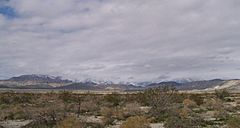Desert Hot Springs (thermal mineral springs) facts for kids
Quick facts for kids Desert Hot Springs |
|
|---|---|
| Miracle Hill | |
 |
|
| Location | Riverside County, California |
| Coordinates | 33°57′40″N 116°30′29″W / 33.96111°N 116.50806°W |
| Spring source | aquifer |
| Elevation | 1,076 feet |
| Type | geothermal mineral springs |
| Temperature | 120°F–160°F |
Desert Hot Springs is a special place in Riverside County, California known for its many hot springs. These springs are heated naturally deep underground. Since 1941, over 200 wells have been drilled here to reach this warm water. About 50 of these wells are used today for spas and swimming pools where people can relax and enjoy the mineral-rich water.
History of Desert Hot Springs
The hot springs were used for hundreds of years by the Cahuilla Native American people. They lived here long before other settlers arrived. The Cahuilla called the area Sec-he, which means "boiling water." The springs were very important to their culture and stories.
In the 1820s, a Mexican explorer named Don José Romero visited the area. He called it Agua Caliente, meaning "hot water." Later, in 1862, the Homestead Act was passed in the United States. This law allowed people to claim land if they settled on it. Soon after, new explorers and settlers began to arrive.
The City of Desert Hot Springs and its Historical Society say that Jack Riley arrived in 1908. However, he did not stay and settle down. They also note that the first non-Native settler was a brave woman named Hilda M. Gray. She started a homestead south of a place called Two Bunch Palms.
Later, in 1913, another homesteader named Cabot Abram Yerxa settled here. He wrote a book called On the Desert Since 1913. In his book, he described the springs at Two Bunch Palms and Seven Palms. He even called the area "Miracle Hill."
In the 1930s, Yerxa and another homesteader, Bob Carr, started to develop the area. In 1941, they opened a bathhouse. Over time, many spa resorts were built here. The area became famous and was known as the "Mineral Water Capital of the World."
What's in the Water?
The hot mineral water at Desert Hot Springs comes out of the ground very warm. Its temperature ranges from about 120°F to 160°F (49°C to 71°C). Both the hot and cold springs in this area have no taste or smell.
The water contains many natural minerals. These include:
- Aluminum Oxide
- Barium
- Bicarbonate
- Calcium
- Chloride
- Copper
- Fluoride
- Iron Oxide
- Manganese
- Magnesium
- Silica
- Sodium
- Sulfate
The water's pH level is about 8.3, which means it is slightly alkaline. Water samples from different parts of the area show slight differences in mineral content. For example, water from the south side of the Mission Creek fault has more calcium and bicarbonate. Water from the northeast side has more sodium and sulfate.
How the Hot Springs Formed
The hot springs are created by a natural process involving water and underground faults. Rainwater from the San Bernardino Mountains flows underground. This water is called Meteoric water. It travels along a geological feature called the Mission Creek fault. As the water flows deep underground, it gets heated by the Earth's natural warmth. Eventually, this heated water rises to the surface in areas with alluvial deposits (loose soil and rock). This is how the hot springs of Desert Hot Springs are formed.


